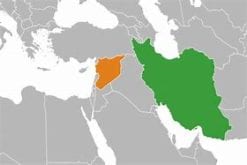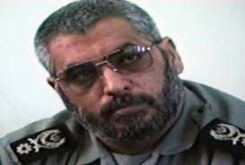Iranwire.com – Throughout the tenure of Ayatollah Khomeini, relations between the Islamic Republic and the Arab countries in the Middle East were tense. Right after the Islamic Revolution, Khomeini had called on the people in Arab countries to rise up against their rulers.

The first major, direct confrontation between the Islamic Republic and an Arab country was over the signing of the 1978 Camp David Accords between Egypt and Israel, which initiated a peace process between these two countries. In a message to then-Egyptian foreign minister Ebrahim Yazdi in April 1979, Khomeini wrote: “Considering the treasonous treaty between Egypt and Israel and the total obedience the Egyptian government to the US and Zionism, the provisional government of the Islamic Republic shall break its diplomatic relations with the Egyptian government.”
The 1980-1988 war between Iran and Iraq worsened tensions in between Iran and the Arab countries of the Persian Gulf Arab. The Islamic Republic’s support for anti-government groups in these countries and repeated talks about “exporting the revolution” drove many of these countries to secretly or publicly support Saddam Hussein’s regime during this eight-year war.
Saudi Arabia publicly supported Saddam, who further garnered the support of Arab countries by calling for “Arab nationalism” over “Persian Shi’ism”. The consequences of this period are still clearly visible today. Furthermore, in 1987, before the death of Ayatollah Khomeini, Saudi security forces attacked Shia pilgrim demonstrators in Mecca and killed more than 400 of them.

Khamenei and the Détente with Arab Countries
After Khamenei took over, the first important event in Iran-Arab relations was the Iraqi occupation of Kuwait and the so-called First Gulf War to liberate Kuwait in 1990. The Islamic Republic declared neutrality in the conflict but, at the same time, grabbed the chance to improve relations with other Arab countries while rubbing their noses in their earlier support for Saddam Hussein.
The first president under Khamenei was Akbar Hashemi Rafsanjani, who sought to rebuild relations with Saudi Arabia. His meeting with the Saudi King Abdullah during the Islamic Summit in 1991 in Senegal played a significant role in this détente. He followed this up with many more meetings with Saudi officials and even visited Saudi Arabia several times during his presidency.
Rafsanjani’s successor, the reformist President Mohammad Khatami, followed suit and more improvements followed in Iran’s relations with both the Persian Gulf Arab countries and Egypt. Khatami’s foreign policy of “rapprochement with neighbors” was more or less welcomed by Arab countries.
Later, however, relations with Arab countries began to sour again after the Islamic Republic started publicly supporting paramilitary groups in the region such as Lebanese Hezbollah, Houthi rebels in Yemen and the more extremist, armed Palestinian groups. The unleashing of the Revolutionary Guards’ expeditionary Quds Force was the logical end-point of this trend under Khamenei’s leadership.
The Bombing of Khobar Towers in Saudi Arabia
Amicable relations between Iran and Saudi Arabia continued into early 1996 but on the evening of June 25 that year, a terrorist bombing of a housing complex in the Saudi city of Khobar – which was being used as the living quarters for personnel of the United States air force stationed at the nearby King Abdulaziz Air Base – killed 19 American airmen and injured 498.
The Saudi government informed Hashemi Rafsanjani that two of the terrorists had escaped to Iran. Iran, however, has always denied that it was involved in this terrorist attack or that it gave sanctuary to the perpetrators. Eventually in 2015, 20 years after the bombing, the mastermind of the attack was arrested in Beirut and was handed over to Saudi authorities. He was Ahmed al-Mughassil, a leader of the Iran-allied Hezbollah al-Hejaz Shia militant group, who was reported to have been living in Beirut ever since the attack under the protection of Hezbollah, Iran’s ally and proxy.
Notably after the bombing, Saudi Arabia did not provide the US with clues it had uncovered about the identities of the perpetrators. In his memoirs, Akbar Hashemi Rafsanjani writes more than once that Saudi officials had sent him messages telling him that they had not provided this information to the Americans because they were hoping the issue could be settled between the two countries.
Documents released by the US National Security Archive reveal that “for at least two years the Saudi government rebuffed U.S. demands for access to critical evidence it had collected from interrogating suspects in Saudi custody” and President Bill Clinton even considered launching an attack against Iran.
The Rapprochement Ends
The American attack on Afghanistan and Iraq after 9/11, and subsequent tensions over the Islamic Republic’s nuclear program, created a new landscape and irrevocably changed Iran’s relations with the West and with the Arab countries. The latter became worried that Iran’s nuclear program would tilt the balance of power in the region to Iran’s advantage. Two events deepened these suspicions: the ascension of Mahmoud Ahmadinejad to the presidency in 2005, and the election of a Shia government in Iraq later that year.
Ahmadinejad became president of the Islamic Republic at a time when, after 16 years of compromise, relations between Iran and its Arab neighbors had been much better than they were in the years following the Islamic Revolution and during the Iran-Iraq war. But even aside from his policies, Ahmadinejad spoke in a manner that injured and humiliated the leaders of Arab countries.
Then came the Arab Spring in 2011-12, and officials of the Islamic Republic paid lip service to protests for democracy across the Arab world. But when the popular uprisings came to Syria, not only did Iran not support the pro-democracy movement but it helped the Assad regime in its brutal suppression of the people. In the civil war that followed, the Islamic Republic sent troops to support Assad, unlike other countries in the region.
Meanwhile, as sectarian violence ravaged Iraq, the Islamic Republic worked to entrench its influence in the country through militias and proxies. Arab countries have repeatedly called for a stop to these “destabilizing actions” by the Islamic Republic and its interference in the internal affairs of other states.
Rouhani’s Administration and the Regional Turmoil
It was in such a situation that Hasan Rouhani took over the presidency and, in his foreign policy, gave priority to resolving the nuclear standoff. From the very first, Rouhani focused his efforts on direct negotiations with the US. This alarmed Israel and Arab countries in the Middle East. The Persian Gulf countries, which for years had been signing security agreements with the US, now found themselves in a situation whereby Washington was negotiating with their Enemy No. 1 in the region.
This led some countries, especially Saudi Arabia and Israel, to expand their actions against the Islamic Republic. Saudi Arabia tried to increase economic pressure on Iran by ramping up its domestic oil production, thus depressing prices, while Israel set out to pressure the White House to put obstacles in the way of a nuclear deal with Iran.
In the meantime, another event further deepened the rift between Iran and Saudi Arabia. On September 24, 2015, a stampede occurred during the Hajj pilgrimage in Mina, Mecca, leading to the reported deaths of over 2,000 pilgrims, 464 of them Iranians. Following the incident, senior officials of the Islamic Republic made harsh statements about Saudi Arabia and on at least one occasion, Khamenei threatened the Saudi government with a “violent response”.
The souring of relations continued apace after this. In January 2016 Saudi Arabia executed Sheikh Nimr Baqir al-Nimr, a Shia cleric and a critic of the Saudi government, along with 46 others. Al-Nimr was a vocal supporter of the mass anti-government protests that had erupted in its Eastern Province in 2011, where a Shia majority have long complained of marginalization. His execution was widely condemned across the world by governments and human rights organizations. Iran said Saudi Arabia would pay a “high price” for the execution and protesters torched the Saudi embassy in Tehran and attacked its consulate in Mashhad. After these attacks diplomatic relations between the countries was cut off.
Five Years of Extreme Tension
Nuclear talks between Iran and the P5+1 group — the five permanent members of the United Nations Security Council plus Germany and the European Union — lasted more than 20 months and eventually led to a deal that was signed in July 2015 in Vienna.
Israel and Saudi Arabia that they would not allow the Islamic Republic to use the financial resources that were to be unblocked after the deal to undermine the security of the region or finance proxy groups. Syria and Yemen were the two obvious examples where the military footprints of the Islamic Republic could be seen.
From the outset of the conflict in Syria, the Islamic Republic used every resource at its disposal — financial, diplomatic and military — to help Bashar al-Assad in the bloody suppression of opposition groups. Arab countries, especially the Persian Gulf states, retaliated by deploying their own resources to topple Assad. Even Turkey joined the fray and Turkish president Recep Tayyip Erdoğan publicly spoke against Khamenei’s policy in Syria.
Conflict Iran and Israel was another by-product of the Syrian civil war. During these years Israel attacked and continues to attack Iranian military positions in Syria but the Islamic Republic has generally avoided responding directly to these attacks.
In Iraq, the Iran-backed Popular Mobilization Forces have occasionally attacked American forces inside the country and are considered a threat by the Sunni Persian Gulf states. Meanwhile, the civil war in Yemen has turned into a full-fledged proxy war between the Islamic Republic and Saudi Arabia.
In recent years, Houthi rebels in Yemen have launched missile and drone attacks on Saudi Arabia, especially on Aramco oil installations, and although the Houthis have publicly taken responsibility for these attacks both the US and Saudi Arabia claim that the evidence shows that the Islamic Republic is behind them.
From an Offensive Position to a Defensive One
Taken together, these developments have made relations between Iran and the countries worse than ever before. In addition the withdrawal of US from the nuclear deal, and the severe economic consequences of Trump administration’s “maximum pressure” policy against the Islamic Republic that have naturally affected its proxies as well, have all seriously weakened Islamic Republic’s ability to carry out its regional policies.
What is more, the rapprochement between various Arab countries and Israel in recent months has resulted in a de facto united front of Israel and Persian Gulf Arab countries against the Islamic Republic. Now, Iran is more isolated in the region more than ever and has been forced to retreat from an offensive position to a defensive one.
 Shabtabnews In this dark night, I have lost my way – Arise from a corner, oh you the star of guidance.
Shabtabnews In this dark night, I have lost my way – Arise from a corner, oh you the star of guidance.


